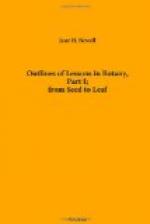4. Root-hairs. These are outgrowths of the epidermis, or skin of the root, and increase its absorbing power. In most plants they cannot be seen without the aid of a microscope. Indian Corn and Oats, however, show them very beautifully, and the scholars have already noticed them in their seedlings. They are best seen in the seedlings grown on damp sponge. In those grown in sand, they become so firmly united to the particles of soil, that they cannot be separated, without tearing the hairs away from the plant. This will suggest the reason why plants suffer so much from careless transplanting.
The root-hairs have the power of dissolving mineral matters in the soil by the action of an acid which they give out. They then absorb these solutions for the nourishment of the plant. The acid given out was first thought to be carbonic acid, but now it is supposed by some experimenters to be acetic acid, by others to vary according to the plant and the time. The action can be shown by the following experiment, suggested by Sachs.
[Illustration: Fig. 12. I. Seedling of Sinapis alba showing root-hairs. II. Same, showing how fine particles of sand cling to the root-hairs. (Sachs.)]
Cover a piece of polished marble with moist sawdust, and plant some seeds upon it. When the seedlings are somewhat grown, remove the sawdust, and the rootlets will be found to have left their autographs behind. Wherever the roots, with their root-hairs have crept, they have eaten into the marble and left it corroded. The marks will become more distinct if the marble is rubbed with a little vermilion.
In order that the processes of solution and absorption may take place, it is necessary that free oxygen should be present. All living things must have oxygen to breathe, and this gas is as needful for the germination of seeds, and the action of roots and leaves, as it is for our maintenance of life. It is hurtful for plants to be kept with too much water about their roots, because this keeps out the air. This is the reason why house-plants are injured if they are kept too wet.
A secondary office of root-hairs is to aid the roots of seedlings to enter the ground, as we have before noticed.
The root-hairs are found only on the young parts of roots. As a root grows older the root-hairs die, and it becomes of no further use for absorption. But it is needed now for another purpose, as the support of the growing plant. In trees, the old roots grow from year to year like stems, and become large and strong. The extent of the roots corresponds in a general way to that of the branches, and, as the absorbing parts are the young rootlets, the rain that drops from the leafy roof falls just where it is needed by the delicate fibrils in the earth below.[1]
[Footnote 1: Reader in Botany. VI. The Relative Positions of Leaves and Rootlets.]
5. Comparison of a Carrot, an Onion, and a Potato.—It is a good exercise for a class to take a potato, an onion, and a carrot or radish to compare, writing out the result of their observations.




